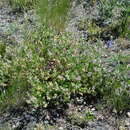Comprehensive Description
provided by North American Flora
Phaca microcystis (A. Gray) Rydb. Mem. N. Y. Bot. Gard 1:245. 1900.
Astragalus microcystis A. Gray, Proc. Am. Acad. 6: 220. , 1864.
Tragacantha microcystis Kuntze, Rev. Gen. 946. 1891.
Astragalus miser M. R. Jones, Rev. Astrag. 98. 1923. Not A. miser Dougl. 1S34.
Perennial, with a woody root and cespitose caudcx; stems decumbent or procumbent, branched, 2-3 dm. long, strigose with curved hairs; leaves 4-6 cm. long; lower stipules connate, the upper distinct, 3 mm. long; leaflets 9-13, oblong or lance-elliptic, obtuse or acute, 6-12 mm. long, pilose with ascending curved hairs below, glabrous or nearly so above; peduncles 1-3 cm. long; racemes about as long, 5-15-flowered; calyx appressed-hairy often with black hairs, the tube 1.5 mm. long, the lobes subulate, 1 mm. long; corolla pink or white, 5 mm. long; banner obovate, deeply notched, abruptly arched, purple-striate; wings much shorter, the blade obliquely oval, rounded; wings still shorter, the blade broadly lunate, rounded at the apex; pod rounded-obovoid, S— 10 mm. long, 5-6 mm. wide, sessile, usually white-pilose with spreading hairs, seeds obliquely round-reniform, 2 mm. long.
Type locality: Interior of Washington. Fort Colville. Distribution: Montana to Washington and British Columbia.
- bibliographic citation
- Per Axel Rydberg. 1919. (ROSALES); FABACEAE; PSORALEAE. North American flora. vol 24(1). New York Botanical Garden, New York, NY
Physical Description
provided by USDA PLANTS text
Perennial, Herbs, Stems woody below, or from woody crown or caudex, Taproot present, Nodules present, Stems erect or ascending, Stems or branches arching, spreading or decumbent, Stems prostrate, tr ailing, or mat forming, Stems less than 1 m tall, Stems solid, Stems or young twigs glabrous or sparsely glabrate, Stems or young twigs sparsely to densely hairy, Leaves alternate, Leaves petiolate, Stipules conspicuous, Stipules membranous or chartaceous, Stipules persistent, Stipules connate to each other, forming a tuber or sheath, Leaves compound, Leaves odd pinnate, Leaf or leaflet margins entire, Leaflets opposite, Leaflets 10-many, Leaves hairy on one or both surfaces, Inflorescences racemes, Inflorescence axillary, Bracts very small, absent or caducous, Flowers zygomorphic, Calyx 5-lobed, Calyx glabrous, Petals separate, Corolla papilionaceous, Petals clawed, Petals white, Petals pinkish to rose, Banner petal narrow or oblanceolate, Wing petals narrow, oblanceolate to oblong, Wing tips obtuse or rounded, Keel petals auriculate, spurred, or gibbous, Stamens 9-10, Stamens diadelphous, 9 united, 1 free, Filaments glabrous, Style terete, Style persistent in fruit, Fruit a legume, Fruit unilocular, Fruit tardily or weakly dehiscent, Fruit oblong or ellipsoidal, Fruit exserted from calyx, Fruit inflated or turgid, Fruit beaked, Fruit glabrous or glabrate, Fruit 3-10 seeded, Seeds cordiform, mit-shaped, notched at one end, Seed surface smooth, Seeds olive, brown, or black.

